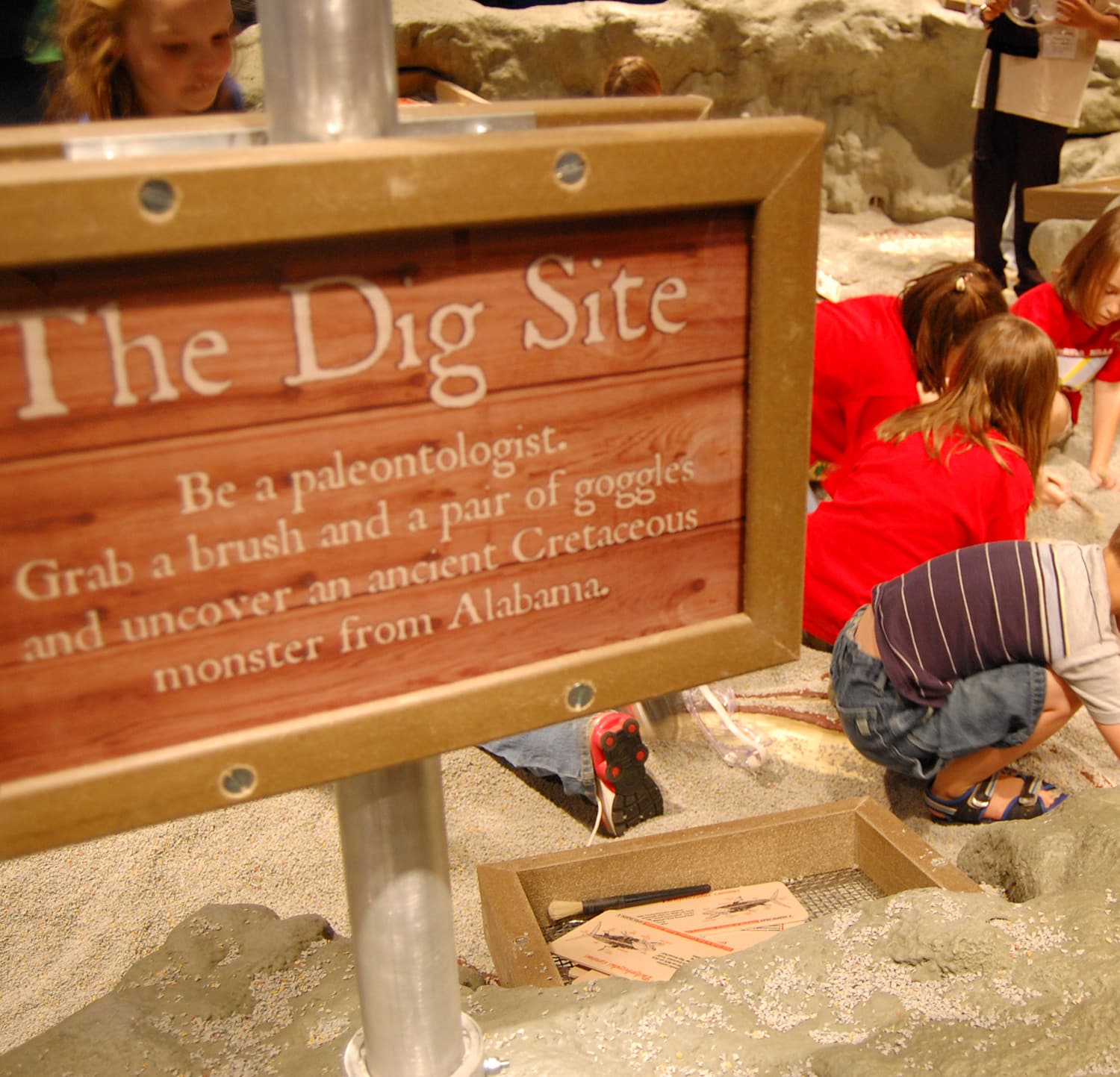Paleontology Collection in Birmingham, AL
McWane Science Center is uniquely positioned as a center of study and learning for curious minds of any age. Whether your child loves dinosaurs or you’re a university professor researching ancient Alabaman oceans, our collections and exhibits offer a world of rare opportunities. Browse our resources below to plan your visit, and reach out if you have questions about performing research with the McWane Collection.

History of the McWane Collection
The history of the McWane Collection begins with the 1970 opening of the Red Mountain Museum, formerly located on the south side of Birmingham. Employees of this City-owned museum spent nearly two decades leading expeditions across the state, collecting tens of thousands of fossils and geological samples. In 1994, the City of Birmingham merged the Red Mountain Museum and nearby children’s museum, Discovery Place, with the private entity, Discovery 2000, Inc. Opened in 1998, this new downtown museum was later named McWane Science Center and now serves as the official repository for the Red Mountain Museum collections. Through continued collecting efforts, the McWane Collection currently stands as the second largest natural history collection in the state.
Alabama Dinosaurs
McWane’s Alabama Dinosaurs exhibit is located on Level 2. This exhibit exclusively features dinosaur fossils that were discovered in our state, one of the richest and most unique fossil zones in the country.
Pronounced: appa-lay-chee-o-saw-rus
Common name: Alabama tyrannosaur
Age: Late Cretaceous Period
Size: 22 feet long
Diet: Carnivore
A relative of T. rex, Appalachiosaurus was the dominant predator in Alabama during the Late Cretaceous Period. The bones on display in this exhibit come from the most complete Appalachiosaurus ever discovered and represent the most complete tyrannosaur ever found in the eastern half of the United States. Unlike T. rex, the arms of Appalachiosaurus were large, perhaps representing the largest arms of any tyrannosaur ever discovered in North America. This skeleton represents the first mounted Appalachiosaurus on exhibit in the world.
Pronounced: no-doe-sawr
Common name: Armored dinosaur
Age: Late Cretaceous Period
Size: 13 feet long
Diet: Herbivore
Nodosaurs were large armored dinosaurs that walked on all four legs. Nodosaurs were slow dinosaurs and likely spent large amounts of time grazing on low-lying vegetation. The backs of these dinosaurs were covered with a series of scutes (also known as armored plating) and bony spikes that helped protect them from any attacking dinosaurs.
Pronounced: dro-me-oh-sawr
Common name: Raptor
Age: Late Cretaceous Period
Size: 9 feet long
Diet: Carnivore
Dromaeosaurs were lightly built, quick-moving dinosaurs that likely hunted in packs. Dromaeosaur jaws were lined with backward-curving teeth, allowing them to better grasp their prey. This dinosaur also had powerful claws on its fingers and a large curved claw on the second toe on each of its feet. It is likely Dromaeosaurs would have balanced on one foot, allowing the other foot to swing forward, and the claw to cut open its prey.
Pronounced: or-ni-tho-my-mid
Name Meaning: Bird Mimic
Age: Late Cretaceous Period
Size: 16 feet long
Diet: Herbivore (probably fruit and insects)
Ornithomimids were fast-running dinosaurs with toothless jaws. They had two hands that were likely used to pull branches with fruit down to feeding height. It is likely Ornithomimids also ate insects as a source of protein.
Pronounced: te-ran-oh-don
Common name: Flying Reptile
Age: Late Cretaceous Period
Size: 25-foot wingspan
Diet: Fishes
Pteranodon was not actually a dinosaur but instead is considered a flying reptile. It’s name means “winged and toothless.” Like modern birds, Pteranodon had light, hollow bones—a trait ideal for flight. Pteranodon could have likely soared for extremely long distances, skimming above the ocean while hunting for fishes.
Pronounced: ik-thee-orn-is
Common name: Fish Bird
Age: Late Cretaceous Period
Size: 1 foot tall
Diet: Small fishes
Ichthyornis was a small bird that once lived in central Alabama near the shore of the Late Cretaceous Inland Sea. It is likely that the tern-sized Ichthyornis looked and behaved much like modern sea birds, and spent the majority of its time flying over the ocean hunting for small fish. Unlike modern birds, the beak of Ichthyornis was full of small, sharp teeth. The bones of Ichthyornis are very small, lightweight, and fragile, so it is very rare to find more than only isolated bones of this bird. McWane Science Center houses one of the world’s largest collections of Ichthyornis remains.
Sea Monsters
Located on Level 2 next to the Alabama Dinosaurs exhibit, our Sea Monsters exhibit features numerous creatures that once inhabited Alabama’s ancient oceans. 80 million years ago, most of Alabama was underwater. Now, everyone from curious kids to university researchers can see first-hand what used to swim where we now stand.
Pronounced: zye-fact-in-us
This species was the largest carnivorous fish in the Late Cretaceous oceans. This specimen is 17 feet long and known for its long, sharp teeth.
Pronounced: pro-toe-steg-uh
This giant’s name means “first roof.” Protostega was one of the largest sea turtles that ever lived. The exhibited specimen is 15.5 feet wide from flipper to flipper and 13 feet tall from head to tail.
Pronounced: pack-ee-rhy-zoe-duss
This specimen’s name means “thick-rooted tooth,” and it stretches 6 feet long from teeth to tail!
Pronounced: cly-das-tes
This specimen, whose name means “one who locks,” is also known as the “Greene County Mosasaur.” It is 11 feet long and was the most dangerous sea monster of its time.